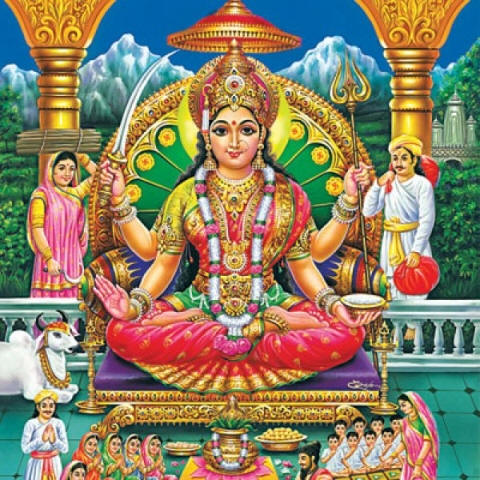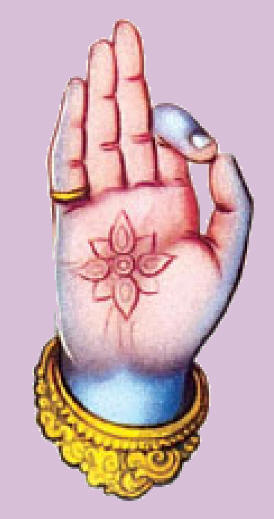GMS = Give Me Sakthi
Published:06 May 2019 8 PMUpdated:06 May 2019 8 PM Sakthi Vikatan
சக்தி கொடு! – 3 = Give Me Sakthi-3
வி.ஆர்.சுந்தரி ஓவியம்: ராஜா By V.R. Sundari. Painting by Raja.
Santhōṣi Māthā is the third eye born divine sister of the Sons of Vinayakar.

1. There is less of what we know and more of what we don’t know. That dearth of knowledge is real, especially of what is around us. We make assumptions, arrive at conclusions, and sweep away established and known facts on faulty hearsay: This is a late arrival; this does not belong to our sect.
2. No one puts forth tenuous arguments (= This is recent, and this came from the North.) and back them up with Rs. 2000.00 bet. Why then all this introduction and build up?
3. For Vināyakar’s daughter. All is for our knowledge of Ambal, who took the Avatar upon the supplication of Vināyakar’s children.
4. Let us sweep aside the futile arguments about the veracity of Piḷḷaiyār’s wedding and his children and go to receive Darśan of Santhōṣi Māthā.
5. Though we celebrate Vināyakar as a Brahmachari, he has two wives (தேவியர்) Siddhi and Buddhi, and a Goddess (Dēvi) Vallabhai. Bhārgava Purāṇam as a part of the Vināyaka Purāṇam is the treatise devoted entirely to the celebration of Vināyakar’s wedding.
6. Let us begin the narration of the auspicious story of Santhōṣi Māthā with the propitious Vināyakar’s marriage.
7. Siddhi and Buddhi, the sisters of Nāradar, and Braḥmadēvar’s daughters married Vināyakar after Tapas (austerity). The sisters had sons, one each: Latchaṉ for Siddhi and Lābhaṉ for Buddhi. Santhōṣi Māthā would be the future sister of these two boys. As usual, the preparatory ceremonies for the same began with Nāradar.
8. Āvaṇi! (August-September). Āvaṇi is the season for a plethora of celebrations in various parts of India. The most special is the Rakshabandhana festival. On the full moon day in the month of Āvaṇi, the North celebrates this festival. The sisters and women celebrate this festival for the prosperity and the welfare of their brothers and families.
9. Witnessing the festival and the joy on that holy day, Nāradar wished to see his sisters and Vināyakar’s two wives, Siddhi and Buddhi. He began his journey.
10. The sisters received Nāradar, who asked them of their weal and welfare, and blessed them. Asked about his joyousness, he described all that he witnessed of the Rakshabandhana festival and elaborated on the sanctity of the relationship between sisters and brothers.
11. Latchaṉ and Lābhaṉ, the sons of Vināyakar, hearing the joyous words of maternal uncle Nāradar begged their father Vināyakar they must have a sister.
12. Then, Vināyakar sat and went into Yogic state in a few minutes. An inundation of light with the splendor of 10 million suns spread around him. From his third eye on Bhrūmadya (middle of the forehead between the eyebrows), an intense light emanated. The gracious look of Siddhi and Buddhi merged with the light from the third eye. That second, a nubile girl with beauty, purity, and auspiciousness emerged.
13. This third-eye-born girl went to her brothers, tied the Kāppu (= காப்பு = Rakshabandhana thread) on the holy wrists of her two brothers, and blessed them. Seeing their wishes materialize before their eyes, the sons of Vināyaka were joyous. All the assembled celestials were ecstatic.
14. At that moment, Malaimakaḷ, Alaimakaḷ, and Kaliamakaḷ with their respective consorts Śiva, Mahāviṣṇu and Brahma arrived. They embraced Vināyakar’s holy daughter. They gave her their Sakthi or power and blessed her.
Malaimakaḷ = Pārvati, the daughter of the mountain. Alaimakaḷ = Daughter of the ocean waves, Lakshmi born in the ocean of milk. Kaliamakaḷ = Sarasvati, Goddess of learning.
15. Soon, Pārvati addressed Vināyakar, “Vināyakā! Your daughter confers joy not only to your sons but also to others. Therefore, we will call her ‘Santhōṣi Mātā.’ All the assembled celestial beings called her joyously in a loud voice, Santhōṣi Mātā.
16. At that moment, Nāradar put forward his request saying, “Vināyakapperumānē! The holy daughter took her Avatar on a Friday. For those who observe Viratam on a Friday and worship her, you must offer them all kinds of help.”
17. Vināyakar: “Nāradā! I bestow all goodness and confer on her the Sakthi so she can guarantee a life of joy to her servitors. Since she received the powers of the Holy Sakthi Triad (Parvati, Mahalakshmi, and Sarasvati), her worshipful servitors will benefit from the grace of the Sacred Sakthi Triad and me. Saying such joyous words, Vināyakar dispensed his blessings.
18. As Santhōṣi Māthā paid homage to the Holy Trinity, the Holy Sakthi Triad, the parents, and the maternal uncle and rose, a roar of auspicious greetings filled the hall.
19. Now, we will learn of Santhōṣi Māthā Virata, rules, obligations, and customs.
20. Santhōṣi Māthā Pūja must be on any Friday beginning in any month. One should get up early in the morning, take a bath, wear clean clothes, and arrange for Pūja.
21. The Pūja area must be impeccably clean. Kōlam with the rice flour should be drawn. The Pūja area should have the picture of Santhōṣi Māthā on a wooden board. Before the image, the Baktha should spread a plantain leaf containing items like a mound of harvest rice supporting a Kalasam (ceremonial pot of water) containing pure water and possibly some coins. The Kalasam must have a corona of Mango leaves at the inner rim encircling a sheared coconut at the opening of the vessel. A lamp with a butter-fed flame is part of the assortment.
22. Can we now begin the Pūja?
23. “Dēvi Santhōṣi Māthā! I seek your grace and mercy and begin this Pūja.” Then, the devotee should declare his intent and need why he performs the Pūja. “Dēvi! Please accept this Pūja and deliver to me your heartfelt mercy and grace.” With that firm supplication, one must begin the Pūja.
24. Beforehand, have a turmeric Piḷḷaiyār. Decorate the Kalasam, Santhōṣi Māthā picture, turmeric Piḷḷaiyār with sandalwood paste. Kum-Kum, flowers, and garlands. Have the fragrant burning incense sticks at the ready.
25. Before Santhōṣi Māthā, have a vessel chockfull of roasted peanuts in shell and jaggery.
26. Vināyaka Pūja comes first before the Pūja of Santhōṣi Māthā. Once the Pūjās are over, one must narrate from a book the story of the greatness of Santhōṣi Māthā Virata Pūja. Later, the devotees should meditate and concentrate their minds on Santhōṣi Māthā and sing the following poem.
|
அன்னையே ஐங்கரன் புதல்வியே
எங்களின் இன்னல்கள் தீர்த்திடுவாய்.
இல்லத்தில் இருந்திடுவாய்
மன்னு புகழ் பெற்றவளே சந்தோஷிமாதாவே
உன்னுடைய அருளை யான் உளம் உருகி வேண்டுகிறேன். |
O, Mother! The daughter of the five-handed
Thou shall remove all our afflictions
And stay in our household
One with eternal fame, O Santhōṣi Māthā!
Your mercy and grace, I beseech with a melting heart. |
27. Once the panegyric and the worship services are over, the roasted peanuts and the jaggery before the picture of Santhōṣi Māthā must be distributed among the assembled devotees and particularly to the children.
28. During the Pūja services, no one should leave the premises for extraneous reasons, and eat any food. Only after the services are over, eating is allowed, that too, meals free of sours like tamarind
29. This service of Santhōṣi Māthā Virata Pūja as explained above, must be continued for 16 weeks and the 17th service will be the last one. Once complete, food is given to eight children, particularly the children of the sister. No Tamarind or any other sour foods, like unripe fruits, are allowed. You can offer clothes exclusive of cash to the children.
30. If you cannot continue the services consecutively week after week due to unavoidable circumstances, it is not remiss, and you can do the services in the next convenient week.
31. Let us supplicate to Santhōṣi Māthā for her grace and mercy!
Let us meet.
End
**************************************************************************************************************************************
The hands are the Fixed Deity.

A. Ēmūr is a sacred site about 8 km from Pālakkāttu. On this temple, Aṉṉai Hōmāmbikai presents herself in the form of hands.
B. Paraśurāmar established the temple for the goddess represented by two hands, one small and the other large, and both get ritual ablution and Pūja services daily. The wonderful hands, which confer sanctuary from fear to the devotees, have the reputation that all supplications made by devotees at this temple come true.
C. One elderly Namboodiri from Kurūr household could not visit his Kuladēvi (family deity) because the temple was far away. The goddess, taking mercy on him, showed her hands at a local holy pond just above the surface in a display of mercy and grace. That sacred spot became the temple.
D. One goddess makes an appearance like the conch-and-discus-bearing Durga during festival celebrations. Ambikai appears in three aspects, firstly as Saraswathi Dēvi in the morning, secondly as Lakshmi at noon and thirdly as Ādhiparāsakthi in the evening. This threefold appearance is Siṛappamsam (சிறப்பம்சம் = special aspects of a goddess). Note: This is analogous to an actress playing a triple role in theater. Example: The Gifted, which first aired in 2017 and ended in 2019, features actress Skyler Samuels playing a triple role as the identical triplets Esme, Sophie, and Phoebe Frost. Source: Wikipedia.
-Mahalakshmi Subramaniyan, Karaikkal